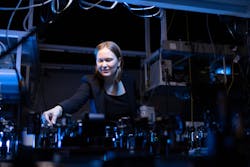Plasmonic metasurface fab process ‘flip’ expands its wavelength range
Colloidal chemistry and the ability to synthesize beautifully shaped nanoparticles in large batches inspired Maiken Mikkelsen and her team at Duke University (Durham, NC) to flip a plasmonic metasurface fabrication process upside down—and it led to a couple of great discoveries.
The team had already trapped light between tiny nanocubes and a metal surface a few nanometers below, so they wondered whether differently shaped nanoparticles could be used to trap light in a similar manner.
“When light hits a metasurface it excites free electrons in the metal so it oscillates—a.k.a. surface plasmons,” says Mikkelsen, a professor of electrical and computer engineering. “Its resonance wavelength depends on the size and shape of the nanoparticles. At this wavelength, light is nearly perfectly absorbed; light at other wavelengths is reflected. This is useful for designing a broad range of devices because it allows you to control which wavelength of light your device interacts with, as well as amplifies this interaction.”
Plasmonic metasurfaces tend to consist of three layers: a metal base is coated in a nanometer-thin transparent spacer layer, and then topped with silver nanocubes. The area of the nanoparticle must be within a few nanometers of the metal surface below, which limited researchers to a small variety of flat shapes.
Just flip it
To maneuver around this flatness limitation, Mikkelsen’s team flipped the traditional fabrication process upside down. Instead of starting out with a metal surface and coating it with a transparent spacer layer, followed by nanocubes, they chose to give each nanoparticle its own dimple or well so their entire lower halves are coated with metal—its sides and bottoms can host plasmons as well.
When a structure looked almost impossible to fabricate at first glance, it became straightforward when made upside down to take advantage of synthesized nanoparticles.
The team effectively enabled another surface of the nanocubes to trap plasmons between gaps, and were then able to experiment in 3D with new nanoparticle shapes, including solid spheres, cuboctahedra (eight triangular faces and six square faces), and metal spheres with a quartz core.
“Using different shapes of nanoparticles allows us to expand the wavelength range of metasurfaces,” Mikkelsen says. “And we can control the local heat distribution of these structures by varying the material and shape of the nanoparticle and underlying film. The heat distribution in our work was found via simulations, next it would be interesting to get an experimental probe of it.”
It would be fun, she adds, to integrate these structures with photodetectors her team recently demonstrated to create on-chip filters over a broad wavelength range for multi- or hyperspectral imaging.
Test results show the new fabrication method goes beyond matching or exceeding the capabilities of previous methods using silver nanocubes—the range of frequencies can be expanded by using different shapes and metals. They also discovered these variations change where the nanoparticles capture energy on their surfaces.
As far as applications, controlling where the nanoparticles capture energy could be key for driving chemical reactions or controlling hot-electron processes. Beyond this, enveloping the entire device in nanoparticles also weatherizes it, so the new approach may find use for thermal detectors or for devices in extreme environments such as space.
Mikkelsen now plans to use the technique to create a supercamera to capture and process a wide range of light’s properties—such as polarization, depth, phase, coherence, and incidence angle.
“If the metasurface is combined with a pyroelectric material—which converts heat generated by absorbed light to a current—it can enable a thermal photodetector where the metasurface acts as a built-in wavelength filter, as we recently demonstrated,” she says. “To create a supercamera, one can imagine using metasurfaces sensitive to other properties of light to capture images with rich information of the environment.”
About the Author
Sally Cole Johnson
Editor in Chief
Sally Cole Johnson, Laser Focus World’s editor in chief, is a science and technology journalist who specializes in physics and semiconductors.

